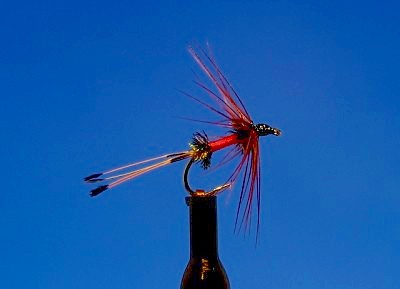
On The Fly
"Fly tying is a school from which we never graduate"
TYING NEWS
The Southern Oregon Fly Tyers invite you to attend their next meeting, Tuesday, December 8,
2009, at 6:30 PM, at the Madrone Hill Mobile Home Park community building near Gold Hill. Bring a
friend, come early so you don't miss anything, and stay late. Tiers need not be experienced, and those with
all levels of skill are welcome. Each meeting a member is encouraged to demonstrate a new or different
skill, from simple to difficult. For more information, call Dan Kellogg at 773-4724.
At the November meeting, Mark Teeters not only taught us how to tie several different
versions of the Boss and Comet flies, he demonstrated several reasons for selecting bead chain over lead
eyes. He also demonstrated how turned up eyed hooks and turned down eyed hooks differ in hooking and
holding abilities. The entire evening was full of great tips and techniques. Thank you Mark.
DIRECTIONS: Take Gold Hill Exit #40, off of I-5 and go west, toward Jacksonville, 1.3
miles, until you reach the brick entrance way to the Madrone Hill Mobile Home Park on the right. Youíll
pass a golf course parking lot on Your left shortly after leaving the freeway. After you turn right into the
mobile home park, proceed to the community building which is located about 100 yards ahead on the left. The
address is 8401 Old Stage Rd. Please park your vehicle on the bare dirt in the parking lot to avoid the
wooden septic covers in the grass.
 PATTERN OF THE MONTH - Royal Coachman Softy
PATTERN OF THE MONTH - Royal Coachman Softy
Hook: Daiichi 1550, standard wet, size 16-10.
Thread: Black, 8-0.
Tail: Golden Pheasant tippet.
Body: Peacock herl, red floss, peacock herl.
Hackle: Coachman brown hen hackle
Tying Instructions
Step 1: Mash the barb and mount the hook in the vise. Start the tying thread one eye width behind the eye
and wrap a thread base back to just above the barb of the hook.
Step 2: Select a small bunch of tippets one shank long and tie it on top of the hook just above the barb.
Trim the butts.
Step 3: Tie on a peacock herl at the base of the tail and wind it forward about 4 touching turns. To
achieve fullness, do not let the herl twist while winding. Tie off and trim.
Step 4: Tie in the red floss in front of the herl butt with a tag end long enough to reach the hook eye.
Bind down the tag end up to the hook eye with close thread wraps forward. Trim the excess and let the
thread hang at this point.
Step 5: Wind the floss forward in smooth touching wraps up to just behind the eye. Tie off and trim excess.
Step 6: Tie in another peacock herl, wind it forward 4 turns, tie off and trim. Be sure to leave room for
the hackle and head.
Step 7: Select a brown hen hackle feather with barbs 2 hook gaps long. Prepare the feather and tie it in at
the base of the herl. Wind the hackle three turns forward while stroking the fibers rearward and holding them
back on every half turn. Tie off and trim the excess. Tie back on the barbs slightly to hold them at a
slight angle.
Step 8: Form a neat, small, tapered head, whip finish and cement.
Unlike most other soft hackle patterns, with colors and shapes imitating a certain hatch,
the Royal Coachman Softyís colors are unnatural. There doesnít seem to be a good scientific explanation as
to why the Coachman style is so effective for any pattern. Based on results it makes a darn good attractor.
We know how well the soft hackle patterns perform when nothing else will. Add the Coachman body to double
the odds. So give it a try, tie some up, give them a test flight and let me know how you do.
Tie One On,
Dan Kellogg (you can contact me at FLYGUY@EZNORTHWEST.COM)